
Pruning and maintaining brambles
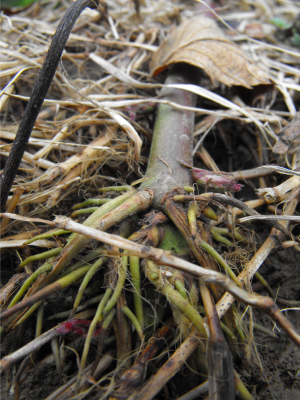 Bramble growth
Bramble growth
Unless you planted
ever-bearing raspberries, you'll spend your first
year watching your berries grow and learning to prune them. That
gives you a chance to get a handle on the unique aspects of bramble
biology
so that you'll understand which canes to cut and which to leave in
place.
The first factor to
consider is how each type of bramble spreads
vegetatively. Blackberries and black raspberries grow long,
arching canes that bend down and then root at the tip. If you cut
the tip loose and dig it up, you can transplant that youngster into a
new part of the garden and expand your patch. Red raspberries, on
the other hand, send out horizontal roots just beneath the soil
surface, then new plants pop up along those roots. If you want to
prevent your berry patch from turning into an impenetrable thicket,
you'll need to understand which type of reproductive strategy your
berries favor and prune accordingly.
The next thing you'll
notice is that most blackberries and raspberries
fruit only on second year wood. The first shoots that come up are
known as primocanes and will only be vegetative, making leaves but no
blossoms. Next year, those primocanes have matured into
floricanes
and will flower and make berries; at the same time, the canes are
sending up new
primocanes to prepare for the third year's berries. After
fruiting, floricanes die and must be removed if you don't want your
berry patch to turn into a thicket. But don't remove the
primocanes or you won't get any fruits next year!
Bramble pruning
Now that you understand
how brambles grow, pruning them should seem less complex.
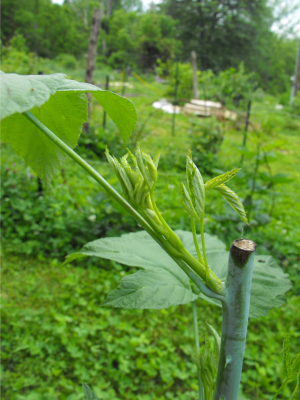
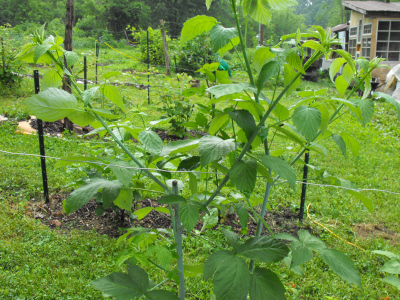
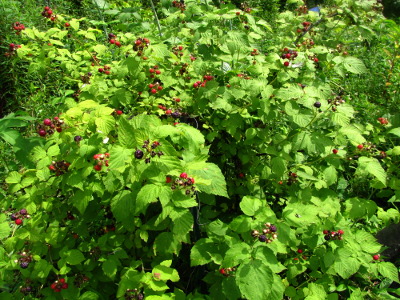
The three photos above show a black raspberry being tip pruned --- first the top is pinched off, then side shoots form, then the next year the bushy plant is loaded with
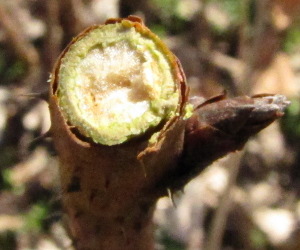
fruits.
The second type of pruning is winter pruning. In early spring, go
into your patch and cut out any dead canes --- you'll be able to tell
which ones are dead because they'll be brown on the outside, often with
peeling bark. If in doubt, cut the top off the cane and take a
peek inside. Living canes will have a ring of green just under
the bark. They'll also tend to have plumper buds.
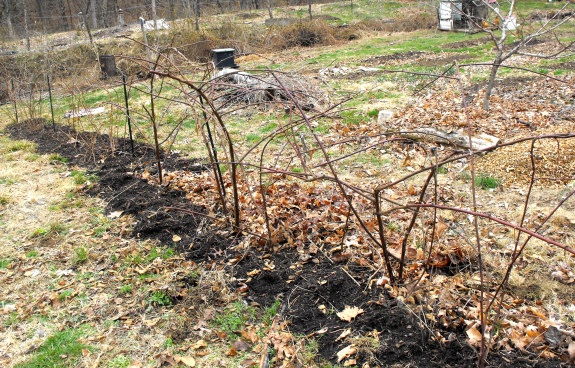
After taking out all of
the dead canes, winter pruning is different for
each type of bramble. If you didn't summer prune carefully or
often enough, blackberries and black raspberries will have reached out
beyond the edges of the row. Prune each plant until the side
branches are one to two feet long. While you're at it, use your
twist ties to attach these new canes to the trellis wires.
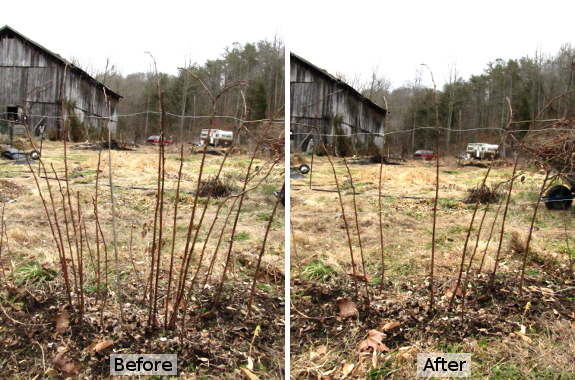
You'll recall that red
raspberries grow differently, sending up new
shoots from their roots rather than making long, trailing canes.
As a result, you only need to prune them once a year, in the
winter. First, cut out any dead canes, then thin until canes are
about six inches apart.
Ever-bearing raspberries
are a bit different because they have two
fruiting periods each year --- one in the spring and one in the
fall. If you only want a fall harvest, pruning is absurdly simple
--- just mow down the whole row of raspberries in the winter.
However, if you want to enjoy raspberries both in the spring and in the
fall, you'll need to follow the advice above for normal red raspberries
and also cut the tops off the canes that fruited the previous
summer. Most people
admonish you to remove the top third of these canes, but the truth is
that you're
cutting off the dead part. After snipping off a few tops, you'll
start getting an eye for the point at which the plump, live
cane turns into the more 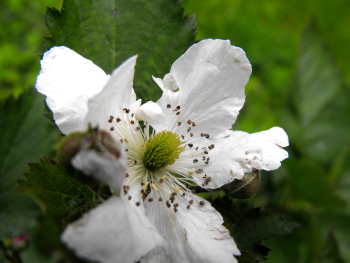 shriveled,
dead cane.
shriveled,
dead cane.
Annual care
Except for the
complexities of pruning, your bramble patch will mostly
take care of itself. Each spring, you'll want to topdress your
plants with compost then smother any potential weeds with mulch.
The brambles will flower and then fruit, generally bearing between late
June and August.
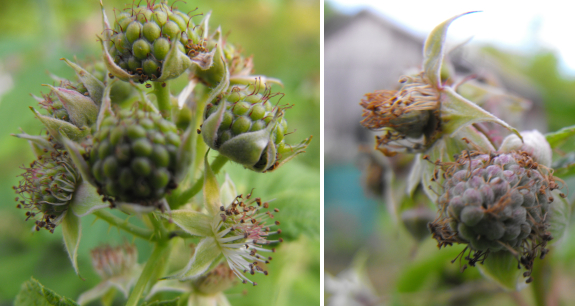
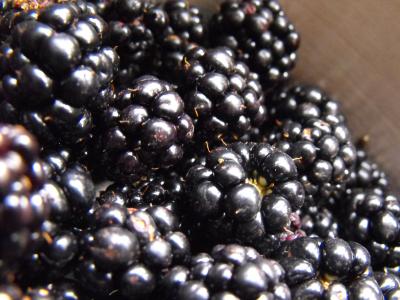 Bramble
fruits tend to be more resilient than strawberries, so you can
probably get away with picking the berries only twice a week. Red
raspberries, though, have a tendency to mold in hot, humid climates, so
harvest more often.
Bramble
fruits tend to be more resilient than strawberries, so you can
probably get away with picking the berries only twice a week. Red
raspberries, though, have a tendency to mold in hot, humid climates, so
harvest more often.
A well-tended patch of blackberries or raspberries can last a very long
time. Keep pruning and mulching and you'll be eating from your
plants a decade or more after planting. Now that's a good return
on your investment!
This
week's lunchtime series is exerpted from Weekend
Homesteader: February,
which is available for 99 cents from Amazon's kindle store. The
ebook
also includes a primer on choosing and caring for a backyard flock of
chickens, information on buying in bulk, and tips for creating your own
apprenticeship. If you enjoy the book, please consider leaving me
a
review.
 This post is part of our Easy Berries lunchtime series.
Read all of the entries: This post is part of our Easy Berries lunchtime series.
Read all of the entries: |
Want more in-depth information? Browse through our books.
Or explore more posts by date or by subject.
About us: Anna Hess and Mark Hamilton spent over a decade living self-sufficiently in the mountains of Virginia before moving north to start over from scratch in the foothills of Ohio. They've experimented with permaculture, no-till gardening, trailersteading, home-based microbusinesses and much more, writing about their adventures in both blogs and books.
Want to be notified when new comments are posted on this page? Click on the RSS button after you add a comment to subscribe to the comment feed, or simply check the box beside "email replies to me" while writing your comment.

I recieved 8 red rasberry plants last spring (for free)! I planted them in a moist lasanga bed and they did well. I was able to pick a few berrys in August.
So I am assuming this is an ever bearing plant because I picked some berrys in August?
Your advise.
Brian --- Keep in mind that variety selection is very region-specific. That said, here are the varieties I've loved and hated:
*Caroline Ever-bearing Raspberry --- This is a workhorse! It produces and produces and produces, and spreads, and spreads, and spreads.
Navaho and Arapaho Blackberries --- These guys just aren't winter hardy enough for our climate. After they got frozen back multiple years in a row, I tore them out.
Some unnamed thornless variety --- Much better.
Wineberries --- These are a wild, semi-invasive species, but I like the flavor. They're not very productive, though --- probably not worth wasting garden space on.
Bristol Black Raspberry --- These seemed pretty similar to wild black raspberries, and not as plump and delicious as some. Need to look harder for a good black raspberry....
Mona --- Definitely an ever-bearing variety if you're getting fruits in August!
I got a couple of raspberry canes in a bare root sale up here in Alaska a few year's back and they grow like gangbusters the first year, but the first year canes never come back the second year to fruit, and the plants still put up new first year canes each year - is this what occured with your "navajo" variety that your ripped out? I guess I always keep rooting that they will overwinter because if they do I'll have more raspberries than I can eat because they come back so well in the spring with new canes...
I welcome any advice!
I was told to pinch off the tips of my red/yellow raspberry primocanes when they reach about a meter tall. I tried this last year, and the canes (like the black raspberries and blackberries) sent so many other branches out and now have fruit all over them. I haven't really paid much attention to how much fruit I get (between kids and crows I only get a handful back to the house), but it looks like I may get a bigger fruit set this way. Have you heard of this method or tried it?